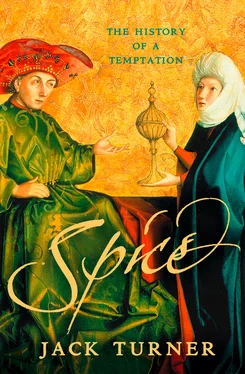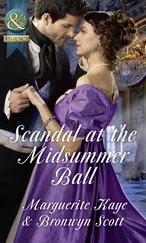But if they were much loved, they were also viewed with mistrust. There was a time not so long ago when the more strait-laced residents of the Maine coast were liable to hear themselves dismissed as ‘too pious to eat black pepper’ – a recollection, perhaps subliminal, of a time when spices were forbidden foods. More than exceptions to a rule, these dissenters help explain an appetite that was ripe with ambiguity and paradox. For when the critics – and they were many – explained what was so objectionable about spices, they tended to single out the reasons that their admirers found for liking them: the merits of flavour, display, health and sexual enhancement transmuted into the deadly sins of pride, luxury, gluttony and lust. These were anything but innocent tastes, and therein lay much of their attraction. It is only by viewing spices in terms of this complex overlap of desires and distaste that the intensity of the appetite can be adequately accounted for – why, in other words, the discoverers we learned about in Aldgate Primary School found themselves on foreign shores, demanding cinnamon and pepper with the cannons and galleons of Christendom at their backs.
All authorities are inclined to inflate the importance of their chosen topic, yet it is my hope that this anatomy of an appetite is not mere antiquarianism. As writers as diverse as Jared Diamond and Günter Grass have observed, food has played a huge role (and a curiously neglected one) in shaping the destinies of humanity – a fact that seems unlikely to change in an age of environmental degradation. Within this field spices occupy a special place. Notwithstanding that they are, in nutritional terms, superfluous, the trade that carried them has been of fundamental importance to two of the greatest problems of global history: the origins of contact between Europe and the wider world, and the eventual rise to dominance of the former – hence, in a nutshell, the academy’s interest. However, in the pages that follow I avoid the larger questions of causation in favour of a more intimate, human focus. This book is written with a sense that history comes too often deodorised, and spices are a case in point. The astonishing, bewitching richness of their past has suffered from being too often corralled into economic or culinary divisions, the essential force of their attraction buried in a materialist morass of economic and political history. Narratives of galleons, pirates and pioneers are more readable but, ultimately, no more explanatory of why that trade existed.
Inasmuch as I have a thesis, it is that spices played a more important part in people’s lives, and a more conspicuous and varied one, than we might be inclined to assume. As whimsical as the claim may seem, there is a deeper historical point. For in the final analysis the great historical developments associated with supplying Europe with spice sprang from a demand: from the senses, hearts and breasts of mankind; from the shadowy realms of taste and belief. In people’s emotions, feelings, impressions and attitudes towards spices all the great, spice-inspired events and dramas, all the wars, voyages, heroism, savagery and futility had their elusive germination. The very existence of the spice trade, Columbus’s voyages in search of the phantom spices of the Americas, archaeologists’ discovery of four-thousand-year-old cloves in the Syrian desert – these are events that can be endlessly speculated upon by historians and archaeologists, with ever greater elaboration and sophistication. And yet it is easy to overlook the question from which the others derive: why the trade existed in the first place. It all sprang from desire.
Very obviously, a subject as ephemeral as this demands flexibility from reader and writer alike. The story of spice consists of a thousand unruly, aromatic skeins of history, and several years spent trying to untangle them has taught me that they refuse to be neatly woven into the straighter, clearer-cut threads that historians conventionally spin across time and space. In lieu of a narrative, I have tried to isolate such traditions as can be drawn out from the huge rattlebag of facts thrown up by such a diffuse topic, to tease out the more important continuities of spices’ past and follow them down through time. The result bears a resemblance to polyphony, albeit without the satisfying resolution.
The book begins with a brief discussion of what historians have called the Spice Race, the crowded decades at the end of the fifteenth century and the beginning of the sixteenth, when Europe poured quite extraordinary energies into the search for spice. The following chapters consider the chief hallmarks of the appetite that drove that search, under the headings of cuisine, sex, medicine, magic and distaste: palate, body and spirit. An epilogue touches on some of the reasons behind spices’ fall from grace, how it was they ceased to be so esteemed, downgraded to the mildly exotic foodstuffs they are today. These are broad horizons, with scant regard for conventional or chronological arrangement, yet I would argue that the merits of the thematic approach outweigh the drawbacks. Medieval and occasionally even modern authorities constantly looked back centuries or even millennia for precedents and justification of their own use of spice; indeed, one of my concerns is to show the extent to which these traditions have survived since remotest antiquity. This is not to suggest that a set of beliefs pertaining to spice survived intact from beginning to end. But I would argue that the spices have their traditions, reverberating with echoes and recollections; that the apparently straightforward act of eating them has been heavily burdened with historical baggage.
There are other advantages in flitting across time and space. If the narrative wanders from one time and place to another, that is exactly what spices themselves have always done, cropping up in defiance of the received wisdom, in places where, by rights, they should never have been. The drawback, of course, is that any one of these themes could warrant several books of its own, and since day two I have felt overwhelmed by the embarrassment of riches. The problem has no easy solution other than a broad brush and a carefree ruthlessness in its use. Where I have resorted to particularly sweeping statements I have tried to flag some of the complexities and nuances of the academic debate, where there is one, in the endnotes.
It might be helpful at the outset to clarify what exactly I mean by ‘spice’. The short list below is far from comprehensive, nor is it intended as a technical guide. There is, in fact, no single, satisfactory definition: ask a chemist, a botanist, a cook and a historian what is a spice and you will get very different responses – for that matter, ask different botanists and you will get different definitions. The history of the word itself, its changes and devaluation, is a theme running through the book.
The OED is, as ever, a good place to start:
One or other of various strongly flavoured or aromatic substances of vegetable origin, obtained from tropical plants, commonly used as condiments or employment for other purposes on account of their fragrance and preservative qualities.
Broadly, a spice is not a herb, understood to mean the aromatic, herbaceous, green parts of plants. Herbs are leafy, whereas spices are obtained from other parts of the plant: bark, root, flower bud, gums and resins, seed, fruit or stigma. Herbs tend to grow in temperate climates; spices in the tropics. Historically, the implication was that a spice was far less readily obtainable than a herb, and far more expensive.
Environment may also account for spices on a more fundamental level. Chemically, the qualities that make a spice a spice are its rare essential oils and oleoresins, highly volatile compounds that impart to the spices their flavour, aroma and preservative properties. Botanists classify these chemicals as secondary compounds, so called because they are secondary to the plant’s metabolism, which is to say that they play no role in photosynthesis or the uptake of nutrients. But secondary does not mean irrelevant. It is generally accepted that their raison d’être is a form of evolutionary response, the plant’s means of countering threats from parasites, bacteria, fungi or pathogens native to the plant’s tropical environment. Briefly, the chemistry of spices – what in the final analysis makes a spice a spice – is, in evolutionary terms, what quills are to the porcupine or the shell to the tortoise. In its natural state cinnamon is an elegant form of armour; the seductive aroma of the nutmeg is, to certain insects, a bundle of toxins. The elemental irony of their history is that the attractiveness of spices is (from the plant’s perspective) a form of Darwinian backfiring. What makes a spice so appealing to humans is, to other members of the animal kingdom, repulsive. *
Читать дальше











